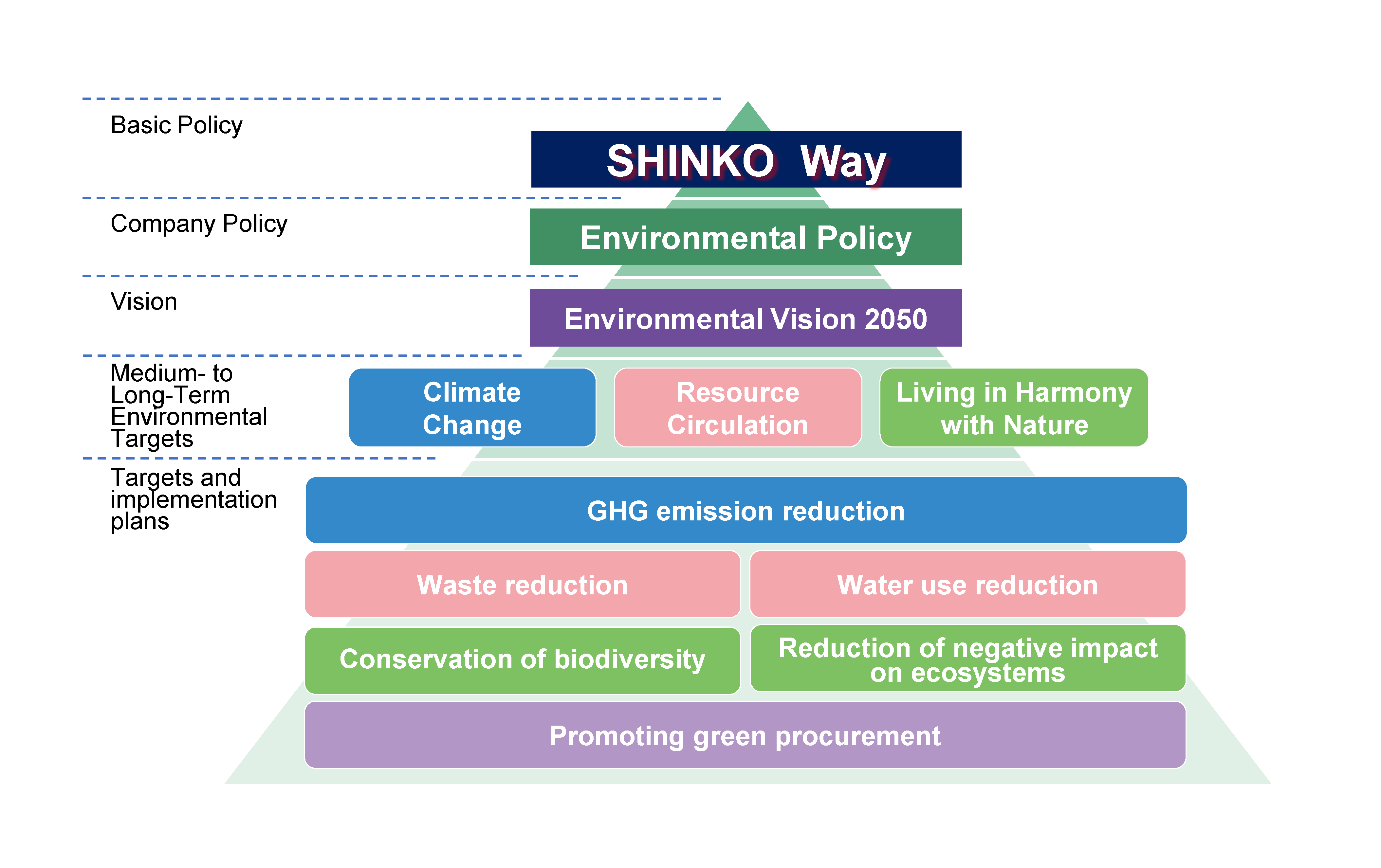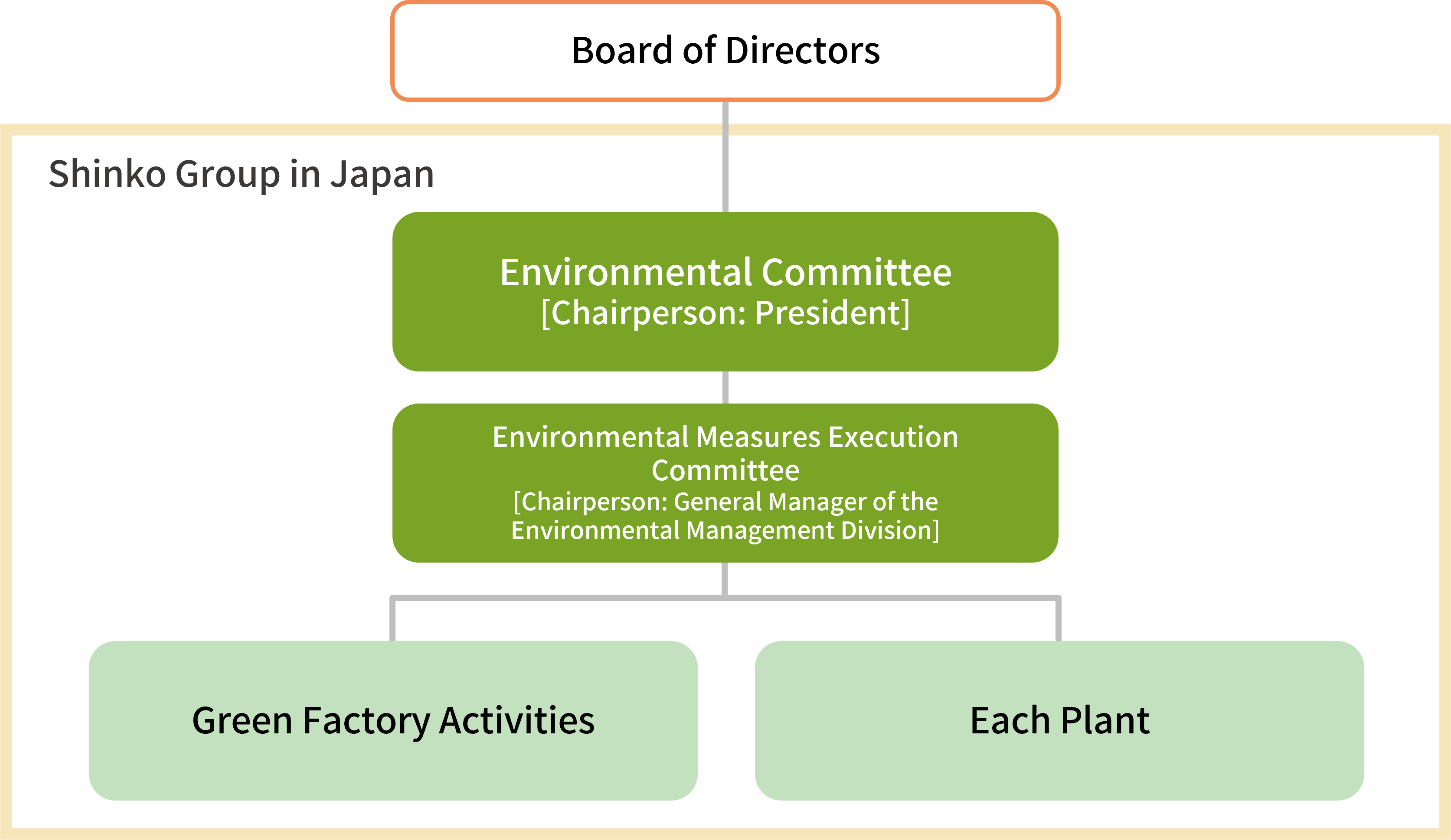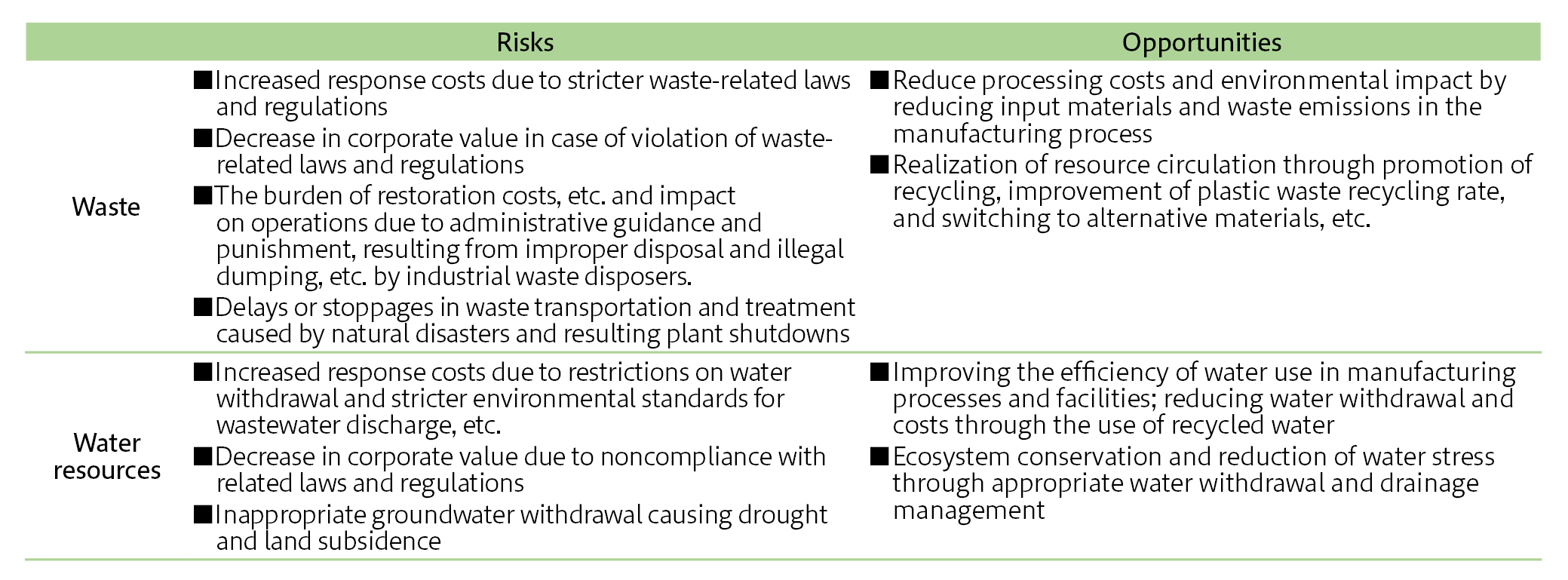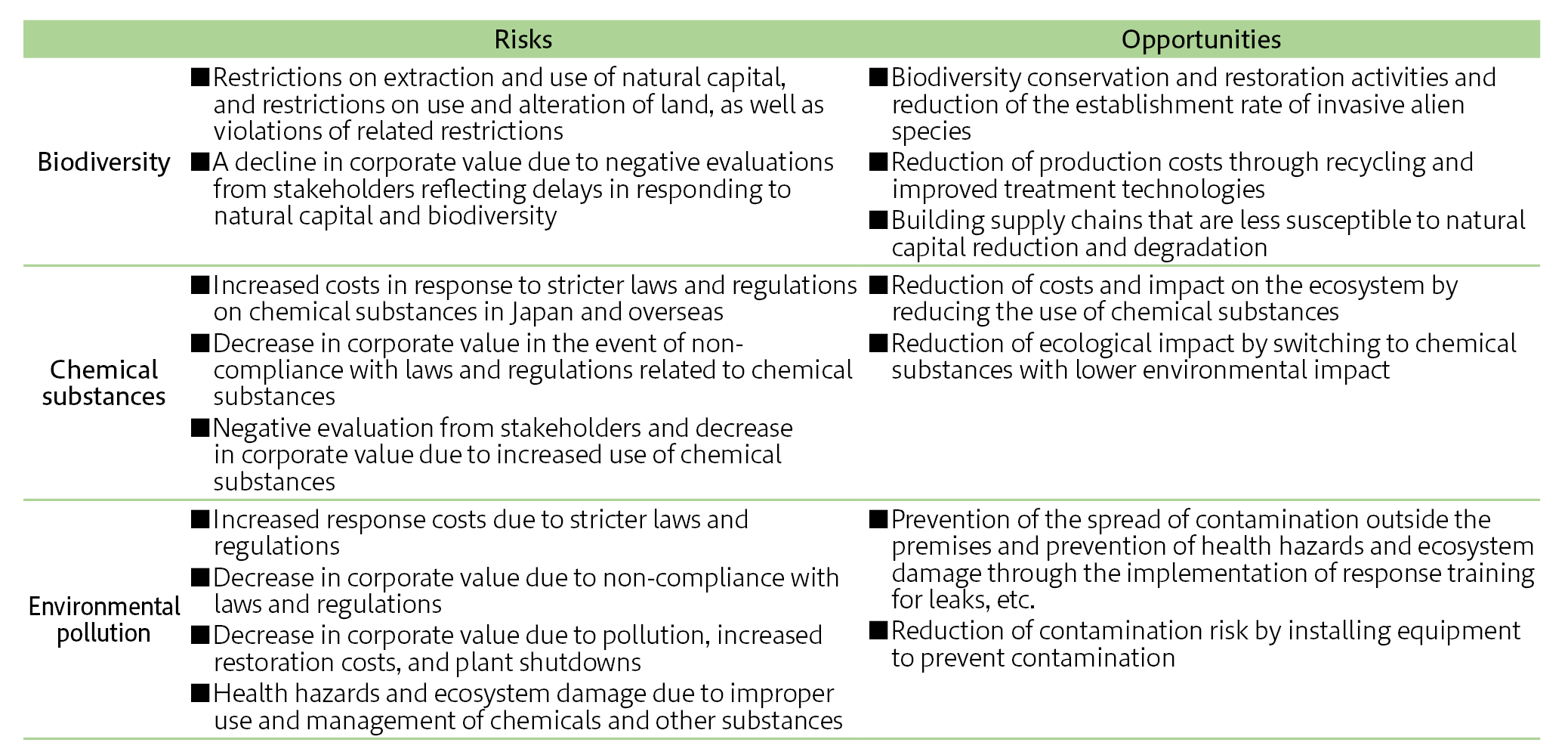
SHINKO ELECTRIC INDUSTRIES CO., LTD.

SHINKO ELECTRIC INDUSTRIES CO., LTD.
To promote environmental management, the Shinko Group has established an environmental management system based on the international standard ISO 14001 as a framework for balancing business activities with social needs and environmental issues. Through the PDCA cycle, we strive for continuous improvement and betterment of our environmental performance.
Reporting boundary: Shinko Group in Japan
We have made environmental protection a top management priority and are engaged in environmental preservation activities based on a promotion system established in accordance with the Shinko Way, the basic philosophy of the Shinko Group.
Environmental Activity Promotion System

To promote environmental management, we have established an Environmental Committee chaired by the Representative Director of Board, President. As the highest deliberative body for environmental measures, the Committee reviews medium- and long-term issues, formulates policies, and proposes, deliberates, and decides upon matters related to environmental management, including measures to address business risks and opportunities related to climate change, resource circulation, and living in harmony with nature. These results are reported to the Board of Directors, which oversees environmental activities. We have established a structure that is described above.
We have also established an Environmental Measures Execution Committee as a subordinate organization under the Environmental Committee to deliberate matters such as the progress of activities to achieve environmental goals. While strengthening governance through the establishment of this promotion system, we are promoting the maintenance and improvement of our environmental management system.
Environmental Management Promotion System

The Paris Agreement1 and the Sustainable Development Goals (SDGs) are accelerating efforts to realize a globally sustainable society, and Japan has declared that it will "Aim for carbon neutrality and a decarbonized society by 2050." In tandem with efforts to fight climate change, global movements to solve social issues are accelerating in such areas as transitioning to a circular economy2, tackling the marine plastic problem, conserving water resources, and achieving a nature-positive3 world.
In light of this situation, we identify the effects that our business activities have on the environment, clarify the challenges and requests from stakeholder related to the environment, risks and opportunities, then determine the environmental issues to be addressed during the year, taking into consideration their importance and urgency. We reflect these environmental challenges in the activities of our environmental management system, and are deploying our initiatives to resolve them.
1 Paris Agreement: An international framework for the prevention of global warming agreed to at the 21st Session of the Conference of the Parties to the United Nations Framework Convention on Climate Change (COP21) held in Paris in 2015
2 Circular economy: A circular economic system that is designed on the premise that recycling and reuse will occur starting at the stage where goods and services are produced. It maximizes the value of resources and products and minimizes resource consumption and waste generation by reducing the input and consumption of new resources as much as possible. Intended to replace the conventional economic system based on the premise of "mass production, mass consumption, and mass disposal."
3 Nature positive: The nature positive initiative seeks to arrest the loss of biodiversity and put the environment on a recovery path. Natural restoration.

> Resource Circulation / Reducing Water Use / Response to water risks

> Living in Harmony with Nature / Conservation of Biodiversity / Addressing biodiversity risks

> Promoting Social Responsibility in the Supply Chain / Business Continuity Management
The Shinko Group is continually making improvements to prevent and minimize environmental risks using our environmental management system. We also prepare to minimize damage in the event of a disaster.
Thorough management through the following measures:
Boiler Fuel
We use natural gas because it produces the lowest CO2 emissions among fossil fuels and releases the smallest amounts of the environmentally harmful substances that are contained in soot and smoke (dust, sulfur oxides, and nitrogen oxides) during combustion.
Soot and smoke measurement
We regularly measure soot and smoke by setting voluntary control standards that are stricter than the national and prefectural emission standards. There were no exceedances of either the voluntary control standards or the emission standards in FY2023.
Exhaust treatment
Some exhaust emissions from manufacturing equipment and wastewater treatment facilities also contain hazardous substances. Such exhaust gas is input to a unit called a "scrubber" so that hazardous substances can be removed and discharged to air.
Management of equipment
Each piece of equipment that uses fluorocarbons is registered in a ledger and given an equipment ID, and a label with the ID is attached to the equipment to manage inspection records and disposal.
Inspection
We strive to prevent leakage of fluorocarbons and detect leakage at an early stage by conducting inspections every three months. If any equipment malfunction is found as a result of these inspections, etc., the equipment is repaired as soon as possible.
Wastewater discharged from plants is detoxified, and its discharge into sewers or rivers is strictly controlled.
The water discharged from our plant is regulated by the Water Pollution Control Act and the Sewerage Act, but we have established voluntary control standards that are stricter than the national and prefectural effluent standards, and we measure water quality regularly to ensure thorough wastewater management.
There were no exceedances of voluntary control standard values or effluent standard values in FY2023.
Storage
We are taking thorough measures to prevent leakage in the storage of chemical solutions and waste liquids. Tanks are systematically updated after a certain number of years, based on the material and the contents. Also, we have installed liquid containment walls around our tanks to prevent leaks in and outside our premises.
Inspection
Liquid containment walls, tanks, piping, etc. are regularly inspected to detect deterioration and anomalies at an early stage, leading to the prevention of leaks.
Training
We also conduct practical response training and protective equipment training in preparation for minimizing environmental risks in the event of a leak.
There was no leakage in FY2023.
We have established voluntary control standards for items based on the Soil Contamination Countermeasures Act and ordinances, which are stricter than the legal standards, and conduct periodic inspections. We confirmed that there was no soil or groundwater contamination in the FY2023.
To ensure early responses to any problems, every plant’s facilities management department conducts comprehensive safety inspections of each equipment twice a year to achieve compliance, environmental protection, and the prevention of accidents. The results of the inspections are horizontally disseminated as necessary to improve safety.
Based on the Company-wide Disaster Prevention Guidelines and Business Continuity Management (BCM), we prepare for the occurrence of natural disasters, and implement measures and training to minimize environmental risks in the event of unforeseen circumstances.
> Climate Change / Information Disclosure Based on TCFD Recommendations / Risk Management
In response to the frequent flood damage caused by heavy rains and typhoons in recent years, we have implemented flood control measures, after referring to hazard maps. We installed waterproof barriers to stop the flow of water as a measure against indoor flooding. In addition, outdoor equipment is raised on platforms so that even if water damage does occur, it will be minimized.
At the newly opened Chikuma Plant (Chikuma City, Nagano Prefecture), watertight doors and shutters have been installed to strengthen flood prevention measures.
Seismic reinforcement work for buildings built under the old earthquake-proofing standards has been completed at all plants, and seismic reinforcement work for rooftop facilities (piping and ducts) is currently underway in sequence.
As part of our business continuity planning, we installed emergency power generators at all plants in case of a largescale blackout due to an accident or disaster, ensuring power for lights, fire alarm systems, and other equipment during a blackout.
We conduct environmental education for all employees in Japan at least once a year to ensure that each employee always acts in an environmentally conscious manner, both in conducting corporate activities and in living as a member of society.
In FY2023, we reincorporated the structure of the environmental management system and the importance of compliance with laws and regulations into our educational materials and provided education.
We disseminate information on a variety of topics throughout the company on a monthly basis, including familiar seasonal themes and environmental issues surrounding our company. In June, Environment Month provides an opportunity to think about a sustainable global environment. We conduct activities such as beautifying the area around our plants and holding environmental quizzes to contribute to the community and raise environmental awareness.
Environmental Education Achievements in FY2023 [Shinko Group in Japan].png](/english/sustainability/images/07717782ffd6692d0f3d35d5d0851e99b1a458e2.png)
Every year we conduct an internal environmental audit to check ISO 14001 conformance, the effectiveness of our environmental management system, and compliance with laws and regulations.
When nonconformity items are revealed by audits, we analyze the causes from multiple perspectives and promptly make improvements. In addition, the results of audits, including conforming items, were shared in the entire company in an effort to continuously improve the management system.
In FY2023, compliance with laws and regulations and recognition of internal standards were added as priority check items.
We have taken corrective action on all audit findings.
We strive to comply with national environmental laws and regulations as well as prefectural and city regulations, pollution prevention agreements, industry guidelines, and environmental requests from customers.
In FY2023, there was one case of failing to observe obligation to comply with laws and regulations, which was appropriately responded to and corrected.
There were no litigation issues, fines, or penalties resulting from violations of environment-related laws and regulations, and there were no accidents with serious environmental impact. Similarly, there were no litigation issues, fines, penalties, or serious accidents at overseas production sites.
Number of Environmental Laws and Regulations Violations or Complaints

Japan: Acquired integrated certification as Fujitsu Group
Overseas production sites: Individual companies obtained certification
| Registration office | SHINKO ELECTRIC INDUSTRIES CO., LTD. Head Office (Kohoku Plant), Wakaho Plant, Chikuma Plant, Takaoka Plant, Arai Plant, Kyogase Plant, SHINKO R&D Center Domestic Subsidiary SHINKO TECHNOSERVE CO., LTD. |
|---|---|
| Certification body | Japan Audit and Certification Organization for Environment and Quality (JACO) |
| Registration number | EC98J2005-D601 |
| Date of registration | September 12, 1995 |
| Certification body | Bureau Veritas Quality International |
|---|---|
| Registration number | MY008657 |
| Date of registration | October 18, 2000 |
| Certification body | Korean Foundation for Quality |
|---|---|
| Registration number | EAC-0642801 |
| Date of registration | July 3, 2003 |